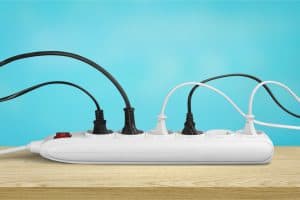Home workstations are usually the most problematic zones when it comes to unsightly cords and cables. So many objects requiring cables go there: a computer charger, phone charger, lamp cable, USB cables, and more. If you’re using a lot of tech equipment, the number of cables goes up.
In this article, we will talk about how to hide cords on the desk so that you don’t feel distracted every time you enter your oasis of focus and productivity.

Do You Need All the Cables?
The first and the most important rule of keeping a tidy workspace is to check whether you really need all of the cables.
If there are some excess cables or objects with cables that you don’t use every day, consider removing them to another place.
For example, you can get a plastic or cardboard box for excess cables and keep it near your desk, so you don’t have to search around to find them.
Another suggestion is to keep them in a dedicated drawer within hand reach.
Furthermore, consider whether it is possible to minimize the number of items with cables by reorganizing or replacing them. For example, there are wireless lamps, monitors, keyboards, mouses, and phone chargers without cords. Some table lamps have built-in wireless phone chargers, so that’s also one less cable. There are also lamps with USB ports for wire chargers, or you can slow charge your phone over your computer USB port and reduce the number of outlets you use.
How Many Pluggable Items Are There?
The right method for hiding the cords in your workspace depends on how many wires there are. Two or three cords call for a simple solution, but dealing with a handful of them may require a more serious system.
For example, it can be good to think about the following:
- How far are the nearest outlets?
- How many outlets are there?
- Where are the outlets located in space?
- Are there enough outlets?
- Should you add power bars?
- Is your workstation in the middle of the room or near a wall?
Another question to consider is how do you conduct your work? Is there a static, permanent setup requiring certain items such as a computer, monitor, or keyboard, or do you often move around the space?
These preferences are essential to determining how to hide cords on the desk.

How to Hide Cords on Desk
In the following paragraphs, we will present you with some of the most popular and efficient solutions for cord management. The methods differ in their complexity, price, and aesthetics, and depending on how you have answered the previous paragraph’s questions; you will know which one is the best for you.
Zip Ties for Clustering Cables
Using zip ties for clustering cables is quite cheap as they cost $5 per set of 8 pieces. They are one of the most common solutions for professionals working with lots of cables, as IT experts or system admins prefer.
Zip ties enable you to cluster cables that belong to the same outlet and prevent them from getting entangled. They also help you shorten the length of longer cables. However, you need to be careful, as you can damage the cables if you overtighten the ties.
Another pitfall to the ties is that they can’t be used more than once. To get them off, you’ll need to cut them, and that means throwing them in the trash afterward.
That’s we recommend getting a large stash of zip ties, with enough pieces to cover you no matter how many times you want to reorganize your cables.
Putting the Cable Inside the Cable Trunking Conduit
If you’re dealing with complex circuits and installations, or if you need to route thicker wiring bundles, you can try cable trunking.
You can go with metal, plastic, or EMC trunking, depending on the style of your space. Metal trunking is the heaviest type of trunking, and it can support multiple cable arrangements. Some are made of galvanized steel and can even protect cables placed outdoor or anywhere else where they might be exposed to moisture. Plastic versions are usually cheaper, and there is huge variability in sizes and shapes.
Finally, the EMC trunking provides electromagnetic compatibility between the cable and the trunking enclosure, minimizing interference and lowering the risk of EM radiation.
Cable trunking allows you to hide the cables; it’s easy to install and will serve your needs for a long time.
Cable Basket for Holding the Cables
One of the simplest ways to hide cords and power strips is to use a cable basket. Simply put the cables and-or the power strip in an open basket or box, and you solve the problem while everything remains easily accessible.
A nice cable basket can be decorative as well as functional, so choose wisely.
Taping the Inside of the Desk Using Masking Tape
Using duct tape or masking tape is one of our favorite household hacks, especially when it comes to hiding wires. The best thing about it? It’s very budget-friendly.
A good tape will hold almost anything in place, and you can use it to disguise the cables passing below the table.
All you need to do is run the wires below the table and tape them to the inside of the table so that they aren’t visible. If your desk is in the middle of the room, and the nearest socket is a bit far, you can try running the cable down the table leg and then via the floor to the nearest power source
Using Cable Organizer Boxes
If there is a power strip on your desk, you can place it in one of those special cable organizer boxes that have suitable openings on each side for the cables to pass through the box. They are usually also quite stylish and provide ample room for keeping various devices, such as a phone or a tablet, on top of them.
The cable organizer box can serve as a charging station for your various devices while preventing your desk from table cluttering.
Using Cable Organizer Clips
Try using cable organizer clips for shorter cords like phone and computer chargers and other desk-based cables. Like the ties, these too are pretty affordable, and they come in many different shapes and styles. They hold your cables in one place and stick to almost any surface.
Using Cable Trays
Cable trays can be very convenient for hiding cables under the desk. You can clamp or nail them to your desk and create a cable storage unit underneath your working surface.
Cable trays are pretty easy to assemble and use. If you have a desk with a closed backside, you can remove cables from sight entirely.
Another helpful alternative is to use adhesive boxes or drawers that can stick on the bottom of the desk just like a cable tray and store your cables and adapters there.
Skirting
If you’re dealing with cables that go through the entire room, perhaps skirting is the right option for you (also known as baseboard).
You can put all of your lengthy wires through a cord cover that can be stuck to the skirting. This will allow cables to run throughout the entire room or even between the rooms without being seen.
Putting Cables Under the Rug
Another solution for chords spread across the entire room is rugs. If you have thick rugs on the floor of your room, you can try passing the cables beneath the rugs.
The thicker the rug, the more you will be able to hide the unevenness that may be forming below the carpet. You can also cover the bumps with armchairs, tables, floor lamps, decoration baskets, etc.
However, the cables might get damaged below the carpet, and you probably won’t realize it until the damage goes too far.
Getting Artistic
Covering and packing up the cords in baskets, boxes, or trays is one way to solve the problem. However, you may want to express your creativity and be practical simultaneously, and we have an idea for that: get artistic with your cables!
You can make cool cable design on the walls or use decorative clips, tape, and stickers to cover them up partially or entirely and have the cables blend in and enrich your interior design.
If you decide to put the cables into cable sleeves and have them still at least partially visible in the room, the decoration can still be an option, and you can turn this boring menace into fun and games with a few stickers and clips.
Conclusion
In an otherwise neat and professionally looking room, cords in plain sight can bother the eye and distract you.
There are many ways to deal with cables in your room that will help you keep them out of sight. However, you first need to think about the composition of your room, the number of cables you have, and how much money you are willing to spend on this intervention.
Finally, if you want, you can also keep some or all of the cables out in the open but change their position and purpose by using them as a decorative element.





